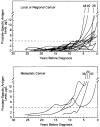Longitudinal evaluation of prostate-specific antigen levels in men with and without prostate disease
- PMID: 1372942
- PMCID: PMC3461837
Longitudinal evaluation of prostate-specific antigen levels in men with and without prostate disease
Abstract
Objective: To evaluate longitudinal changes in prostate-specific antigen (PSA) levels in men with and without prostate disease.
Design: Case-control study of men with and without prostate disease who were participants in a prospective aging study.
Setting: Gerontology Research Center of the National Institute on Aging; the Baltimore (Md) Longitudinal Study of Aging.
Patients: Sixteen men with no prostate disease (control group), 20 men with a histologic diagnosis of benign prostatic hyperplasia (BPH), and 18 men with a histologic diagnosis of prostate cancer.
Outcome measures: Multiple PSA and androgen determinations on serum samples obtained from 7 to 25 years prior to histologic diagnosis or exclusion of prostate disease.
Results: Changes in androgen levels with age did not differ between groups. Control subjects did not show a significant change in PSA levels with age. There was a significant difference in the age-adjusted rate of change in PSA levels between groups (prostate cancer greater than BPH greater than control; P less than .01). At 5 years before diagnosis when PSA levels did not differ between subjects with BPH and prostate cancer, rate of change in PSA levels (0.75 micrograms/L per year) was significantly greater in subjects with prostate cancer compared with control subjects and subjects with BPH. Also, rate of change in PSA levels distinguished subjects with prostate cancer from subjects with BPH and control subjects with a specificity of 90% and 100%, respectively.
Conclusions: The most significant factor affecting serum PSA levels with age is the development of prostate disease. Rate of change in PSA levels may be a sensitive and specific early clinical marker for the development of prostate cancer.
Figures



Comment in
-
Cancer of the prostate.JAMA. 1992 Dec 9;268(22):3196; author reply 3199. doi: 10.1001/jama.268.22.3196b. JAMA. 1992. PMID: 1279228 No abstract available.
-
Cancer of the prostate.JAMA. 1992 Dec 9;268(22):3196; author reply 3199. doi: 10.1001/jama.1992.03490220040012. JAMA. 1992. PMID: 1279229 No abstract available.
-
Cancer of the prostate.JAMA. 1992 Dec 9;268(22):3197; author reply 3199. doi: 10.1001/jama.268.22.3197c. JAMA. 1992. PMID: 1279230 No abstract available.
-
Prostate-specific antigen. Improving its ability to diagnose early prostate cancer.JAMA. 1992 Apr 22-29;267(16):2236-8. doi: 10.1001/jama.267.16.2236. JAMA. 1992. PMID: 1372945 No abstract available.
References
-
- Wang MC, Valenzuela LA, Murphy GP, Chu TM. Purification of a human prostate-specific antigen. Invest Urol. 1979;17:159–163. - PubMed
-
- Stamey TA, Yang N, Hay AR, McNeal JE, Freiha FS, Redwine E. Prostate-specific antigen as a serum marker for adenocarcinoma of the prostate. N Engl J Med. 1987;317:909–916. - PubMed
-
- Cooner WH, Mosley BR, Rutherford CL, et al. Prostate cancer detection in a clinical urological practice by ultrasonography, digital rectal examination, and prostate-specific antigen. J Urol. 1990;143:1146–1154. - PubMed
-
- Catalona WJ, Smith DS, Ratliff TL, et al. Measurement of prostate-specific antigen in serum as a screening test for prostate cancer. N Engl J Med. 1991;324:1156–1161. - PubMed
-
- Hudson MA, Bahnson RR, Catalona WJ. Clinical use of prostate-specific antigen in patients with prostate cancer. J Urol. 1989;142:1011–1017. - PubMed
Publication types
MeSH terms
Substances
Grants and funding
LinkOut - more resources
Full Text Sources
Other Literature Sources
Medical
Research Materials
Miscellaneous

